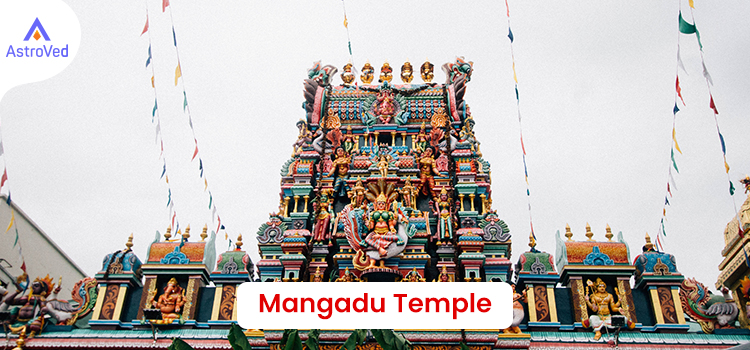The Mangadu Temple in Chennai, Tamil Nadu, is dedicated to Goddess Kamakshi Amman, an incarnation of Goddess Parvati. This region was once a dense forest of mango trees. ‘Maa’ means ‘mango’, and ‘Kadu’ means ‘forest’ in Tamil. Hence, the place got the name Mangadu. The temple is also called Sri Kamakshi Amman Temple. Mangadu is a small town 24 km from Chennai. It is on the way from Poonamallee to Kundrathur. This is one of the most visited temples in Chennai, drawing huge crowds on Sundays and Fridays. The temple is administered by the Hindu Religious and Charitable Endowments Department of the Government of Tamil Nadu.
Locals call this the temple of “Tapas Kamakshi.” This is where Goddess Kamakshi performed penance in Panchagni to marry and reunite with Lord Shiva. She supposedly performed all 32 types of Dharmic rituals here.
Despite being a Shaivite shrine, the temple has idols of Vishnu as well. Here, Vishnu holds the Prayoga Chakra in his right hand, which is quite unique. Many sages and revered people have visited this shrine.
The Legend behind the Temple
The story goes that when Lord Shiva and Parvati were in Mount Kailash, the Goddess who was feeling playful, closed the eyes of Shiva. Hence, the entire universe plunged into darkness. Shiva was very annoyed and told Parvati to perform Tapasya and atone for her mischief.
So Parvati came to earth and performed penance amidst Panchagni or five Agni kundams. Standing near the central Agni kundam, she kept the toe of her left leg in the fire and her right leg on her left thigh. Her left hand was on her navel, and in her right hand over her head was a Japa mala. She then began a rigorous penance with her eyes closed. Pleased by her penance, Shiva told her to reach Kanchipuram so that they could get married.
The Goddess left the place without dousing the fire. The heat of the fire caused severe discomfort to all the living beings in that area. This also created fear and awe in the minds of devotees. Adi Sankara, the sage who installed all the Sankara Madams in India, sensed the plight of the people during his meditation and decided to do something about it.
During his pilgrimage, he visited Mangadu and installed a “Sri Ardhameru Chakram” at this place. This helped quench the heat of the fire and transformed the place into a soothing and sacred spot where people could come and pray. The Sri Chakra he installed has 43 triangles or Trikonas and comprises 8 herbals called Ashtagandams. Even now, devotees can see the “Chakra” in the sanctum sanctorum of the temple. This Chakra is a Tantric form of the Goddess, so Mangadu is important for Tantric worshippers as well.
Architecture of the Temple
The temple is over 2000 years old. It features the Chola architectural style of construction. The 7-tiered Raja Gopuram (main entrance) is a recent addition to the temple. It faces the south direction and has many sculptures on it. However, many devotees also use the east entrance, where there is a market along the road that leads to the east gate. They can buy flowers, lemons, and other Pooja items here before entering the temple.
On entering the temple, a Ganapati shrine to the left of the main entrance is visible. From the main hall, one proceeds to the sanctum which houses the Ardha Meru Maha Yantra and an idol of Goddess Kamakshi. The Sri Chakram is the main deity here. Only Kumkuma Archana is performed to it. No Abishekam is done due to the herbs in it. The base of the Chakra has a Koorma or tortoise design with 3 steps above. On this base are 16 lotus petals and over this there are 8 more petals. On the top of this petal base is the image of the Sri Chakra. On Vijayadasami day of Navaratri, it sports a gold kavacham, and on other days, a silver kavacham.
The Sri Chakra here is one of a kind which we cannot see anywhere else.
It was Kanchi Paramacharya who established the shrine and idol of “Tapas Kamakshi” here. The idol of Goddess Kamakshiamman is of Panchaloha (5 metals). When the Guru visited the place, he instinctively understood that people were hesitant to enter the shrine as they felt afraid. To remove this fear, he reinstalled the Goddess’ idol on the left hand side in the main sanctum sanctorum, with a sugarcane in one hand and a parrot in the other. Following this, the Goddess emanated radiance and peace.
One can see other deities like Lord Surya in the outer courtyard. The Sapta Matrikas are in the main outer courtyard. The Dhwajasthambha is in the eastern side. People come here to pray for marriage, progeny, promotions, purchasing a new house, etc.
After praying at the Kamakshi Temple, devotees visit the Vaikunta Perumal shrine for Vishnu, which is about 500 m away. This completes the pilgrimage. Vishnu is in a seated posture along with his 2 consorts, Sridevi and Bhoodevi. He has a ring in his palm that he supposedly brought for the marriage of his sister Kamakshi. This small temple has separate shrines for Goddess Lakshmi, Sri Andal, and Lord Hanuman.
Rituals of the Temple
Devotees pray on a day of their choice for six weeks continuously. This pleases Goddess Kamakshi, who will then grant the boons they seek.
Offerings at the temple include turmeric, vermilion, flowers, coconut, camphor, 2 lemons, betel leaf, and areca nut. According to custom, the devotee offers two lemons to the Goddess, and the priest returns one to them, which they keep in their Pooja room at home. The next week they visit the shrine, bringing this lemon along with the other two fresh lemons. One will again be returned to them. In the third week, this lemon, along with three other fresh lemons, is offered. In the 6th week, the priest will not return any lemons. The devotee also offers milk sweetened with sugar/honey/ cardamom to the goddess on the 6th week. After the Pooja, they share the milk with other devotees in the temple. This method of worship supposedly brings wish fulfillment. People can do the 6-week worship at home, too, by keeping a lemon in front of Goddess Kamakshi’s image and doing the Pooja.
Festivals at The Mangadu Kamakshi Amman Temple
Chithirai Thiruviza is celebrated for more than 10 days. Navratri falls in the month of October to November. Masi Magam is also celebrated at this temple.
Benefits of Worshipping at the Temple
The Mangadu Kamakshi Amman Temple is believed to be a power spot that is filled with divine energy. Devotees believe that Goddess Kamakshi will answer their prayers.
The temple is popular among students appearing for exams, job aspirants, people who wish to get married or have progeny, Tantric practitioners, etc. Once a devotee’s wish is fulfilled, they come here and offer a sari to the deity.
How to Reach
By Air
The temple is 17 km away from Chennai Airport.
By Rail
Pallavaram is the nearest Railway station.
By Road
Mangadu Bus Stand, at a 250 m distance, is the nearest bus stand.
Temple Timings
Morning: 6 am to 1:30 pm
Evening: 3 pm to 9:30 pm


